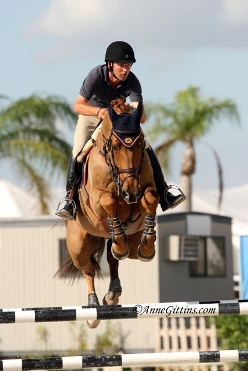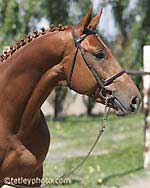Bratt Z
A Valuable Contribution to the Sport
Horse Gene Pool
This young stallion, Bratt Z, is a wonderful example of many of the breeding principles I have outlined on this website--so many, that I am having a difficult time knowing where to start. He is an important addition to the sport horse gene pool.
When I add stallions to my database I usually notice when they have an interesting pedigree, but they quickly fade in my mind as I make more entries. So, it was only when I had a client that needed a sex-balance cure for the male overload in her filly of Corde la Bryere SF lines that I remembered Bratt Z. The client had bred a filly that had many of the great Holstein bloodlines, but most were in the male-only representation. This is common. A successful stallion will usually have many stallion sons--who in turn will have many progeny. The female side of the line will have fewer individuals.
As breeders of horses that we want to succeed at sport, we should keep in mind that continually breeding back to only the male side of the superior talent transmitters will deaden the transmission of sport and breeding potency.

[Pictures of Bratt Z are under copyright and used only by permission]
So then, first and foremost I bring this young stallion to your attention because he carries the cure for an all male Corde line overload, and a Raimond-Ramiro male overload balance.
Bratt Z carries the often missing female element of these lines. Bratt is very interesting for some other reasons such as, he is a good example of
Sibling Power and an example of how to build
potency into a breeding and how to do an outcross breeding while not losing the potency. Bratt Z possesses a classic jump pedigree with tremendous pre-potency for jump going back through the generations.
Bratt Z- seven generation pedigree
Bratt Z and his amazing sire: Baloubet du Rouet SF carry a potent sex balanced double of the premier jump transmitter: Rantzau, through a son- Starter, and a daughter- Perle de Norval. This sex balanced Rantzau is concentrated on the dam side, as Starter is the dam sire and Perle is 3rd dam of Baloubet. This configuration undoubtedly has "made" Baloubet as both a jump star and as a sire (sex-balanced inbreeding to Rantzau). Perle and Starter have more in common than their sire, they carry opposite sex lines of Orange Peel and Karikal on their dam sides, making them close siblings. Therefore, their daughters are a strong filly factor and contribute hugely to both Baloubet and Bratt's success as a sire. The Orange Peel duplication is enlarged and reinforced by its presence on Baloubet's top line, and being the original super jump line in the Selle Francais, here in multiples, sex balanced, insures Baloubet would himself be a great jump star.
On the jump factor, Baloubet du Rouet SF has since I first wrote this article risen to the position of #1 sire of jumpers in the WBFSH rankings (of warmblood breed calculation only). Also I have traced the jump factor back to its main root sources, surprisingly the top jumpers all carry 'critical mass' in just a few Thoroughbred or Trotter sires. In this case it is critical mass in the Irish TB Birdcatcher and the English TB Clemence, who are behind much of the jump ability in the warmbloods. For example, both Rantzau and Orange Peel carry critical mass in them. There are other main jump roots, such as Lexington RH and Vandal RH which are root jump lines of American origin--you may read all about the jump sources in the Thoroughbred in Legacy of Lexington or see the proof in the Show Jumper Hall of Fame analysis.
The Thoroughbred Industry discovered that inbreeding to siblings builds speed. In sport horses this would translate, not only as speed, but possible nimbleness-handiness. Baloubet, who carries Rantzau 3x4, would exhibit this by being able to take jumps, even at odd angles and make tight corners, all at high speed.
On his dam side, Bratt has strong linebreeding, 5x5x6
(engine room) to Ramzes, through three lines of two daughters who are 5/8 sisters
(filly factor and sibling power) in his dam sire: Capitol I HO. These sisters, Vase HO, present twice through a son and daughter, and Retina HO through a son, making them both a filly factor and a colt factor 2x2x3. With this close up genetic power is it any wonder that the Capitol I HO bloodline is so enduring and potent? All these Holstein jump lines carry critical mass in Birdcatcher and Clemence. So at its source all the jump talent in the Holstein springs from its Thoroughbred lines.
Looking at just the seven generation pedigree we might assume that there are several potency deadening all male lines in Bratt: Orange Peel, Loretto HO and Heintze HO. But in each case there is an unseen sex-balance in the 7th through 10th generation. For instance, Tardive HO in the 7th generation is an Orange Peel daughter.
While Bratt is not inbred himself, he is out of two tightly bred parents (see similar patterns in Mumtaz Mahal). He would be classified as an outcross--or even a cross breed, depending on your point of view. To me he is a perfect example of how to construct an outcross successfully. As breeders there may be a time when you have already constructed several tight potent bloodlines into your horses, and want to bring in something new. If you use an outside stallion who is not tightly bred himself, you will end up with an inconsistent product, and possibly even unsoundness, but more importantly you will dilute the genetic power from the parents. Bratt's pedigree is beautifully balanced, and an illustration on how to outcross effectively. The super sire Landgraf HO is another example of successful outcrossing.
My client, whose need originally caused me to look closely at this young stud, had a filly with Constant HO and Calypso I HO close up--Corde sons. Baloubet's Rantzau lines were a cure and improver for this imbalance. The client's Ramiro HO male lines would be helped by Bratt's genetics also. Ramzes AA, Ramiro's grandsire, is here through two daughters: Vase HO and Retina HO, who with their respective Lorbeer HO/Loretto HO lines are also 3/4 sibling to Raimond HO, the sire of Ramiro HO. Further they are present through two sons and a daughter, which in turn makes the daughter a genetic sister to Ramiro HO. Capitano HO also is a genetic relative of Ramiro HO: Capitano HO is out of a Cottage grandson son and a Ramzes daughter, while Ramiro HO is out of a Cottage Son daughter and a Ramzes AA son--this is wonderful complexity.

The combination of Bratt Z with a mare that carries a Ramiro HO daughter line and a Corde line of any sex would put these genetics into high gear. The pedigree experts recommend that when one horse has a strong genetic concentration, that a successful breeding will result when the mate carries the background reinforcement to those strong duplications. This is the beauty of Bratt Z, for those breeders who have a strong Corde or Ramiro HO presence; this young stallion can only improve and expand those talents.
When I first recommended Bratt Z to my client he was still a young stallion and held a breeding license with the Canadian Warmbloods (still does), but now he also is approved with the American Holstein Horse Association. This is fortunate, for he is the perfect genetic compliment for many Holstein mares.